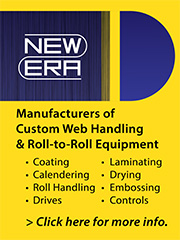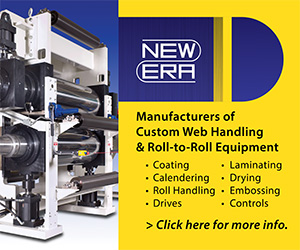Technology Improvements and Emerging Markets Drive Growth in Metallizing
- Published: February 01, 2003, By Robert W. Marsh
Business is good at Applied Films, says Liz Josephson. Vacumet is expanding, but Bob Korowicki says some metallizers are in trouble. Frank Sereno is bullish: “We are having a good year at Proma.”
Josephson, manager of systems sales for Applied Films Corp., Longmont, CO, is bullish, too. She says, “We see the health of the web coating industry as fine. In 2001 we sold 21 machines worldwide. Business slowed after September 11,” she says, but “in January [2002] it started to pick up again.”
However, Paolo Raugei, executive VP, Galileo Vacuum Systems, East Granby, CT, sees problems for metallizers. He puts it this way: “During the past year, imported metallized films have put additional pressure on domestic metallizers. While the current exchange rate parity of the US dollar should make imports from Europe and possibly Asia less competitive, US metallizers must recognize they are facing competition from foreign companies that have invested heavily in new machinery and technology over the last few years. In my opinion, state-of-the-art equipment and manufacturing facilities are the major competitive advantage in our industry. This trend also may lead to additional consolidation in the US.”
Korowicki, president of Vacumet Corp., Wayne, NJ, sees problems, too, even though the 33-year-old company is expanding again. “Our industry is in the most jeopardy I have seen in my 30 years in this industry. From my perspective, the financial outlook is not too healthy. We have seen constant shrinking in the number of our competitors and a continual reduction in margins, which restricts the cash available for replacement and expansions.” Vacumet metallizes plastic films in New Jersey, Georgia, Connecticut, and Illinois and metallizes paper in Indiana and Tennessee.
“We continually reinvest in state-of-the-art hardware to bring down our variable costs so we can compete at the established levels and continue to thrive. The successful companies are able to reinvest to stem the tide of shrinking margins. They will be around tomorrow and in the continuing years to service the markets they have created.
“Although the market continues to grow steadily,” Korowicki explains, “market share shifts from one converter to another. Unfortunately, the shifts are due to pricing and margin reductions. The secondary and smaller players get to the point where they can no longer support the current pricing level. The industry lost two metallizers last year.”
Madico Inc., Woburn, MA, a producer of reflective/safety window films, was not one of them. According to Tom Niziolek, marketing manager, “Our business is healthy. The demand for window films to help control energy in corporate buildings and other large facilities has been growing since the early 1990s. Lately, customers also became aware of the need for safety and wanted window films that would prevent broken glass from becoming a flying projectile. That's why we combine safety and solar control properties in one window film.”
A Global Viewpoint
From a global perspective, growth in the use of metallized films and papers in North America is slowing, while it remains high in India and mainland China, according to Dr. Bill Llewellyn, an associate of AWA Alexander Watson Assoc. In the study recently published by AWA and sponsored by AIMCAL (Association of Industrial Metallizers, Coaters and Laminators), the North American Free Trade Agreement (NAFTA) market is expected to grow at about 2.7% through this year. The study anticipates 3.9% growth in Europe, 5.3% in Asia Pacific, 4.3% in South America, and 6.5% in the rest of the world. At the same time, competition will increase. “If you look at the existing capacity utilization of machines, it is very low,” says Llewellyn, adding, “This picture is further complicated by the increasing globalization of manufacture. Europe has always been a net exporter of metallized material, but now maybe some of those export markets will be denied by indigenous metallizers.”
The newer metallizing equipment to which Llewellyn refers comes from such companies as Applied Films. Josephson says, “Mechanically, we can build a machine that runs as fast as our customers need. The limiting factor right now is the evaporation rate. In evaporation, you can do only so much that the industry is demanding. The rate is limited by the boats used to evaporate the aluminum. Another factor is how good the barrier properties need to be. We have done some work on increasing boat life and having new controllers in our system. We're looking at new steps, which include working with boat manufacturers and also with the film companies. Working in combination is important, because certain films can handle certain rates better than others.
“One of our primary customer markets in the US,” she says, “is film manufacturers that purchase machines with three-meter-plus widths. We also have a four-meter machine in production, but worldwide 1.6- to 2.4-meter machines are more common.”
Machine width isn't, of course, the only thing metallizers are looking for. “They are asking for increased moisture and oxygen barriers for food packaging,” says Josephson. “In addition, we see volume building for clear barrier films, particularly in Europe and Japan. And we're getting requests for super barriers for LED and similar display applications.
New Uses for Metallized Paper
Some customers are expecting new things of the metallized paper produced by Proma Technologies, Franklin, MA, says Sereno. “They're pushing us to produce coatings that are brighter and shinier to differentiate them from printed silver. [The coating beneath the metal determines its reflectivity.] Coating the paper first makes it more receptive to metal deposition and makes the end product look brighter and shinier. We have a number of development programs underway on traditional coatings as well as non-traditional coatings.”
Regarding new applications, Sereno points to “the use of our metallized holographic products in food packaging and medical supplies to reflect sunlight and keep the goods inside colder.” Honolulu Fish Co. in Hawaii ships its exotic fish to mainland restaurants and hotels in a custom holographic corrugated box that features Proma's HoloPRISM holographic paper. “The entire box is a hologram,” says Sereno. Proma's customer reports its employees take the boxes home to use as coolers for food and beverages and sunshades for their cars.
During the recent holiday season, shoppers throughout the world saw holographic CDs produced by Proma Technologies that were on display in 65 A/X Armani Exchange stores. The 72- and 40-in.-dia CDs were an integral part of Armani's national advertising campaign: “Dance Space — a celebration of music and style.” This holiday display is said to be the world's largest mass-produced embossed hologram project.
In its retail-support program for the launch of the Winston Evo Flask line extension, R.J. Reynolds Tobacco Co. turned to Proma Technologies for help in the production of point-of-sale materials such as shelf hangers and shelf talkers. This paper holography project required the production of more than 80 custom holograms.
First-of-Its-Kind Study
Packaging materials loom large in the future of metallized films and papers as reported in the “New Metallized Papers & Films World Sourcebook 2002.” Packaging accounts for some 55% of all metallized materials. The main growth drivers of metallized packaging materials have been barrier properties, recyclability, and esthetics. Now, however, they include the increased functionality of clear coatings. The sourcebook covers papers and films metallized by direct and transfer processes.
Worldwide demand for metallized products amounted to about 463,000 tons in 2001 and is expected to grow at an annual rate of 4.1% by the end of 2003 for a total of 501,500 tons. Europe is identified in the sourcebook as the leading market for metallized films and papers. It accounts for 36% of the world's consumption followed by NAFTA at 30%, Asia Pacific at 19%, and South America at 3%. Plastic film appears to be the substrate of choice with 63% of all metallized materials. Paper is second with 33%, followed by board at 3%, and all others just 1%.
Metallizers and machinery manufacturers are working to improve technology. For example, Applied Films is working on its electron beam metallizers “to bring optical qualities closer to those of sputtering,” says Josephson.
In sputtering technology, the company recently introduced a multi-web sputtering machine designed to increase productivity, reduce downtime, be ergonomically friendlier for operators, and cut turnaround time in half. “The real growth in metallizing,” Josephson believes, “will be in flexible applications such as personal digital assistants (PDAs), cell phones, and other small, portable display applications. There's a growing interest and focus on flexible displays right now.”
For Vacumet's expansion program, Korowicki worked with Galileo to design two metallizers he believes “have the highest throughput of any non-captive machine made to date.” At 130 in. wide, with a 50-in. roll diameter capability, one of them is said to be the largest machine of its type. “This is a true merger of experience, technique, and technology,” he says, “and includes surface treatment equipment that will enhance metal adhesion and barrier. We're actually in a learning process to determine which combination of properties will modify the surfaces of the substrates we metallize and give our products new characteristics.”
Contributing Editor Robert W. Marsh is former executive director of the Assn. of Industrial Metallizers, Coaters & Laminators and a retired marketing communications manager for ICI Americas, where he managed advertising, sales promotion, and product publicity for Melinex polyester films. Prior to joining ICI, he handled advertising assignments for DuPont Co.







